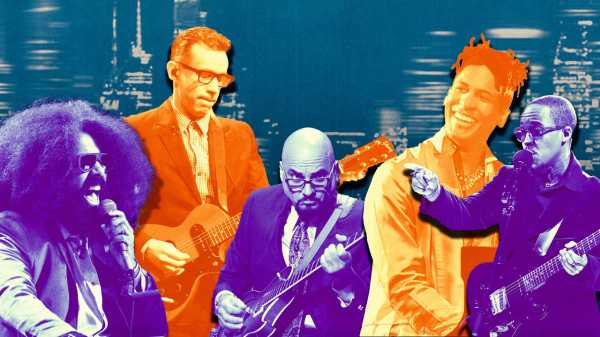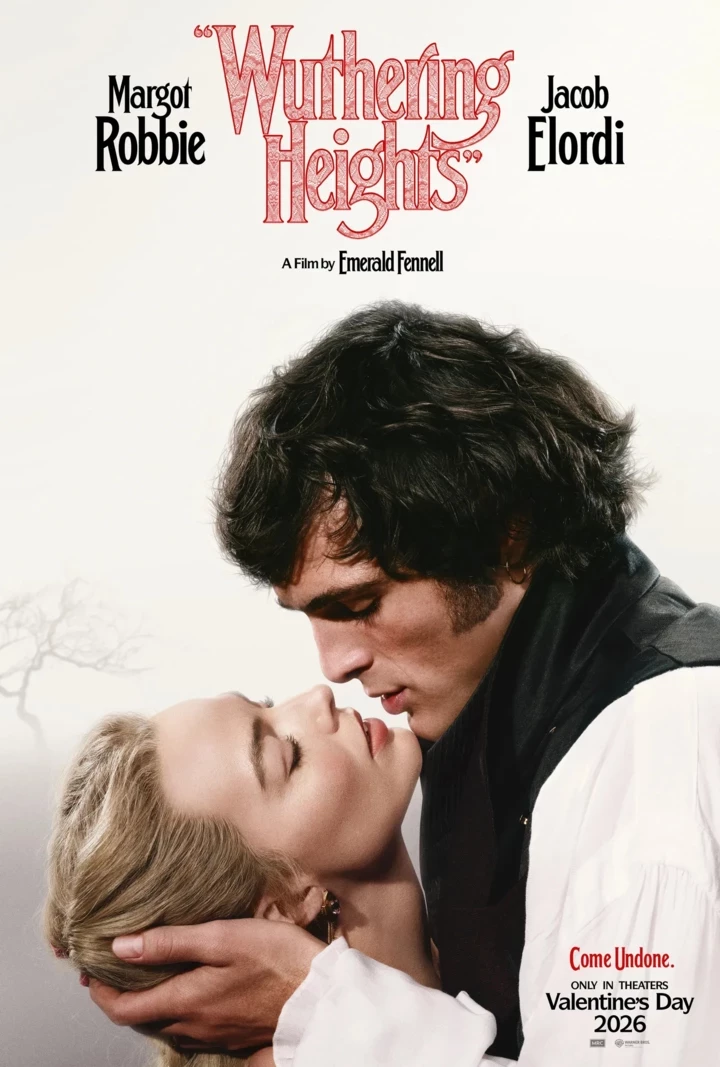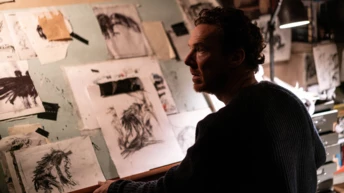
Save this storySave this storySave this storySave this story
There’s a moment from a 2012 episode of Conan O’Brien’s former TBS show that I think about often. O’Brien’s guest, the comedian Eric André, sits down and grabs a microphone from the host’s desk. “Is this my microphone?” André asks, while trying to figure out a way to attach the desk mike to his shirt. Then he retches and picks up a nearby coffee mug. “What’s in here, oatmeal?” he asks. For anybody familiar with André’s comedy, which relies on the shocking and the absurd, all of this makes sense.
André settles in for a minute, riffing with O’Brien about his own series, a parody of late-night talk shows, which had recently premièred on Adult Swim. Then, as O’Brien is speaking, André suddenly stands up and yells, to O’Brien’s bandleader, “Jimmy Vivino, hit me!” Vivino is on it in an instant. We hear a pick slide, and the Basic Cable Band gets into an uptempo vamp. “Two times,” André says, and the band responds with two horn hits. “Three times,” he says. Three hits. Then the punchline: “One hundred times,” he shouts. The band plays twenty-three hits before O’Brien waves them off.
The Lede
Reporting and commentary on what you need to know today.
I’d always assumed this was a pre-planned shtick, but Vivino recently assured me that it had been spontaneous. “It wasn’t like Eric said to me backstage, ‘We’re gonna do this,’ ” he explained. “Every single person in that band was also a bandleader, so they pay attention one hundred per cent of the time, knowing that at any time it could be them.” André’s stunt demonstrated the comedic possibilities of having a group of skilled and alert performers on the payroll.
There are fewer and fewer of those: the late-night-television industry has been contracting for years, and musicians have been early casualties of the cost cutting. In 2019, TBS whittled O’Brien’s show, “Conan,” down to a half-hour program, without Vivino and the band, before cancelling it entirely in 2021. “The Late Late Show with James Corden” ended in 2023, taking the five-piece group fronted by Reggie Watts with it. In 2024, the Fred Armisen-led 8G Band was laid off from “Late Night with Seth Meyers.” “The Late Show,” which made the bandleaders Paul Shaffer and Jon Batiste into household names, will go off the air in May, 2026. Louis Cato and the Late Show Band will be out of a gig.
The late-night format is confronting a variety of challenges, many of them arising from the internet. Celebrities now promote new projects by going on “Hot Ones” or “Chicken Shop Date,” or by posting to their own social-media profiles; seeing them on linear television can feel stale. People increasingly watch late-night shows in clip form, on YouTube, rather than staying up and watching them when they air. The economics of the endeavor make less and less sense: “The Late Show with Stephen Colbert” was the top-rated program in its time slot by a wide margin; even so, it was reportedly losing at least forty million dollars a year. “There may be wonderful, creative people working doing the shows, but everything is driven by money,” G. E. Smith, who led the “Saturday Night Live” band from 1985 to 1995, told me. “And if you know that going in I think you can stay a lot saner, knowing that it’s only temporary.”
A d.j. is cheap and a playlist cheaper still; financing a nightly variety show full of world-class performers is expensive. And paying somebody to wait for a moment that may never come is a tough sell. The end of the late-night house band may not be a major tragedy, but a world without it does feel—to me, at least—diminished. “A band gets energy in people. It makes something feel special. It creates anticipation,” Ian Karmel, a writer for the “Tonight Show,” told me. “It’s Stage 1 of welcoming you to this world. It excuses what’s about to happen, which is a very silly thing.” Silly, and also communal: the band underlines the live, in-person togetherness of the format, which was always meant to have a broad appeal, and which was—by necessity, in the early days—of the moment. Whatever replaces it will, if current trends are any indication, be very different.
Steve Allen was a pianist, so, when he was developing the “Tonight Show” in 1954, music naturally became part of the program. The late-night talk show was an experiment; Allen, the show’s first host, was making it up as he went along. “It was such a fledgling medium that the audience was watching to see what would happen,” Mark Malkoff, who hosts the podcast “Inside Late Night” and is the author of a forthcoming book about Johnny Carson, said. “The band members started to become household names. This was a new medium, but this was going to be the blueprint of what would be for the next sixty years.”
At the time, lots of musicians were employed by networks—even local affiliates had orchestras available to fill programming needs. The phenomenon of the late-night show helped some of them become personalities. A pianist named Skitch Henderson had filled in as the conductor of the NBC Symphony Orchestra, but serving as the bandleader on Allen’s late-night program is what made him a star. When Johnny Carson took over as the host of the show, in 1962, he locked in the format that persists today. But Carson didn’t yet have the clout necessary to bring in a bandleader of his choice—at first, he worked with Henderson, and then another NBC musician, Milton Delugg. It wasn’t until 1967 that he got the man who would define his program’s look and sound.
While playing theatres across the country, Carson had worked with a young trumpeter named Doc Severinsen, who had been hired as an NBC studio musician at twenty-two and played lead in Henderson’s orchestra when Allen’s show first aired. He proved to be the perfect foil on Carson’s show, with the confidence of a lead trumpeter and the humility to be the butt of a joke. “Doc Severinsen was a life preserver for Johnny. He always knew if a joke tanked that he could make fun of Doc’s outfit, which would get a reaction from the audience,” Malkoff said. Severinsen wore purposely garish suits, turning himself into a character.
As the “Tonight Show” grew, both NBC and other networks tried to replicate its success by piloting similar programs. Each time a new show premièred, it came with a new house band meant to convey why this program was different from the others. When David Letterman made his late-night début on NBC at 12:30 A.M., in 1982, he wanted a rock-and-roll band for the looser, more rebellious show he would lead. In Paul Shaffer, he found a bandleader who could set the show apart from the brassy sound of Carson’s 11:30 P.M. program.
“I may have been one of the first to use rock and roll as my repertoire on a talk show. I’ve heard that music clearance is the most expensive part of the show and that’s because I played so many oldies, but God love them I think they understood that was part of the fun of the show,” Shaffer told me. Shaffer was a member of the original “Saturday Night Live” band and had quickly distinguished himself as a multitalented performer, as comfortable appearing in sketches as he was playing keyboards on the bandstand. He also, like Severinsen, favored gaudy clothing that Letterman could always, in a slow moment, make fun of.
Shaffer’s four-piece group, the World’s Most Dangerous Band, was faster and more reactive than Severinsen’s big band on the “Tonight Show.” Shaffer was a musical encyclopedia, and his band prided itself on being able to respond almost instantly to anything that happened on the show. Letterman, as Shaffer pointed out to me, “was certainly among the most spontaneous of the hosts. So you had to be ready for anything.”
The gig is demanding, but steady, which helps explain its appeal to musicians who have already reached the top. Before Conan O’Brien went to TBS, he occupied Letterman’s chair at “Late Night” for sixteen years. His band in those days was led by Max Weinberg, who’d got his big break two decades earlier, with Bruce Springsteen and the E Street Band. When Jimmy Fallon replaced O’Brien, in 2009, he set his sights not only on a famous bandleader but a famous band: he told producers that he wanted to hire the Roots, who’d made two gold records. Nick Bernstein, a veteran late-night executive, loved the idea, but figured it wasn’t realistic. “My thought was, That would be incredible, but I can’t imagine that they have a great interest in being in one place for four or five days a week in a city they don’t live in. How do you convince them of that?” To his surprise, the pitch worked.
Fallon now occupies the spot created by Allen and cemented by Carson on the “Tonight Show.” The Roots came with him. On the weekends at NBC, “Saturday Night Live” still has an in-house band, too, led by Lenny Pickett, a saxophonist who took over from G. E. Smith in 1995, a down year for the show that led Lorne Michaels to clean house. I remember watching an episode of “S.N.L.” as a kid, having recently been assigned the saxophone in the school band. As the host said goodbye, I locked in on Pickett, who had previously been a member of the funk band Tower of Power, and who was soloing in the background as the cast hugged onstage. He kept going higher and higher into the altissimo register, until his tenor saxophone sounded like a whistle. I had no idea a saxophone could sound like that. I went to bed thinking about what I’d just heard; maybe one day I could play notes that high.
The other members of the band may not be famous, but the gig remains life-changing. In 2022, the trumpeter Summer Camargo was twenty years old and a student at Juilliard when she got a call from Pickett, who gave her a job after a Zoom audition. Each week that fall, she’d go to class, do her homework, and then, on Saturday evenings, sit in view of millions on national television, over the host’s right shoulder during the monologue, trying not to break. The gig is just one day a week, but that day is long—an 11 A.M. call time and a series of rehearsals lead into a nighttime session driven by the band. At 7:30 P.M., they play covers of classics from the sixties and seventies to rev up the crowd. Every week, Keenan Thompson, Ego Nwodim, Chloe Fineman, and Heidi Gardner come out and sing “Gimme Some Lovin’ ” with the band. “I’m playing for about six hours before the actual show happens,” Camargo said.
Camargo makes enough from “S.N.L.” that she doesn’t need to take any other gigs. She can decide what suits her artistically and decline everything else. She gets offered more work than she needs. For working musicians, or modern creatives of any kind, stable work is a luxury. Having a salary is like winning the lottery.
This wasn’t always the case, Vivino explained to me. In the seventies and eighties, there was ample work for studio musicians. “There would be three guitars, you know, two keyboard players, a bassist, a drummer, and a percussionist, and it would be an eight-piece rhythm section. We’d be cutting disco songs and they’d throw a chart in front of you,” Vivino said. “You’d do two or three of those a day, and some jingles.” It was easier for musicians to make ends meet. But drum machines and synthesizers began replacing live instrumentation. “It went away. It’ll never come back.”
Louis Cato got his fateful phone call in 2015, when he was living in Boston. Jon Batiste wanted him to produce a studio session in New York. “I would later find out that it was for producing what would be the theme song to Stephen’s ‘Late Show’ taking over for Letterman,” Cato told me. Batiste then asked him to join the band. The show went on air that September, and Batiste’s group, Stay Human, became a standout part of the program. During the next few years, Cato would fill in as bandleader whenever Batiste was out. He took over full time in 2022.
The gig was draining. Programming music four or five nights a week and keeping the crowd energized before shows added up to more than one job—it was overwhelming even for someone who’d spent years going from tour to studio session without any stops. Cato found himself too exhausted to cook at night, sometimes too tired even to order delivery. But he learned to structure his life in a way that made it all possible. Soon, that will all end.
G. E. Smith saw Cato days after he got the news. They were putting on a show together in the Hamptons. “He was pretty upset. But I got to sit down and say, ‘Man, when I got canned from “Saturday Night Live,” I got, like, a two-week notice. You got ten months to pull your shit together, and you’re so good, and everybody knows you are. You’re gonna be fine, you know?’ ” Smith said. “And I think in his heart he knows that.”
I sensed as much when I asked Cato what it will mean for culture at large when the live television band, something that has been an American institution for seventy years, goes extinct. He was philosophical. “The format, having this high-level musical and cultural exchange being packed into suburban America’s living rooms, is changing,” he said. “But if we were setting out to make a bunch of money we wouldn’t have started making music. That is not a sound business model—pun intended. But I think those elements, spiritually, are things that don’t go away.” ♦
Sourse: newyorker.com







